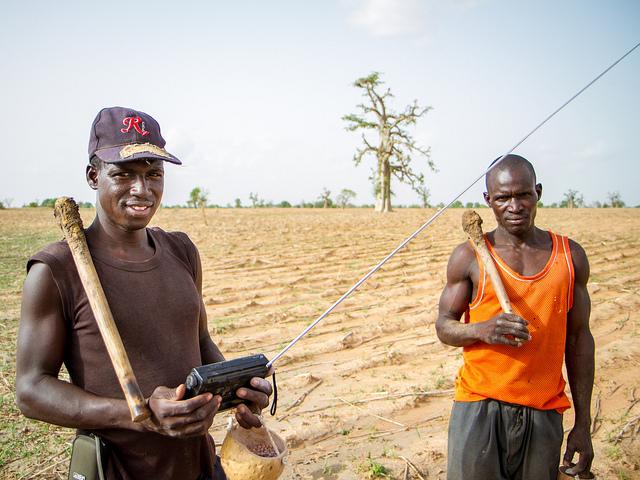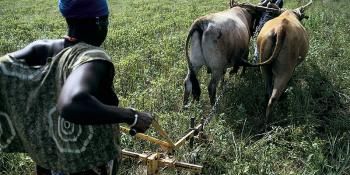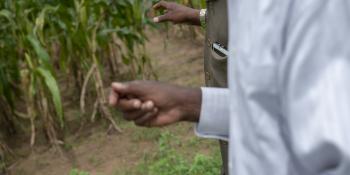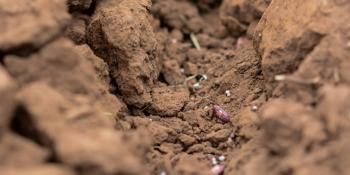Climate-smart agriculture takes root in Africa

As we celebrate Africa Environment day, we highlight Climate-Smart Agriculture and its potential in addressing some of the pressing environmental and developmental challenges facing the continent.
“There are opportunities even in the most difficult moments,” said Wangari Maathai, the internationally renowned activist acknowledged for her struggle for democracy, human rights, and environmental conservation.
Dr. Maathai frequently narrated her childhood experience: a world where food was present in the farms all year round and birds would chirp as frogs croaked in anticipation of the rains. Today, over 50 years later, Africa is a different place. Climate related shocks such as droughts and floods are more frequent and are altering how people gain access to food, changing the balance between work, trade and transfers.
As we mark the Africa Environment Day on March 3, we highlight climate-smart agriculture (CSA) practices and their potential in improving productivity and livelihoods. Climate-smart agriculture is the result of practices and technologies that sustainably increase productivity, support farmers’ adaptation to climate change, and where possible reduce levels of greenhouse gases. CSA can also help governments to achieve national food security and poverty reduction goals.
In Africa, a number of CSA practices have already been trialed and adopted through projects initiated by a number of partners. These include the East African Dairy Development project implemented by Heifer International in partnership with the International Livestock Research Institute (ILRI), TechnoServe, World Agroforestry Centre (ICRAF), African Breeders Service Total Cattle Management, and farmers; Drought Tolerant Maize for Africa coordinated by International Maize and Wheat Improvement Centre (CIMMYT) and the International Institute of Tropical Agriculture (IITA). Others include Conservation agriculture in Malawi and Zimbabwe and the Africa Risk Insurance Mechanism. These initiatives (and many others) have yielded much lessons and are transforming Africa’s agriculture into a more sustainable and profitable sector. These are documented in a recent booklet co-published with the Technical Centre for Agricultural and Rural Cooperation (CTA).
Learn more: Evidence of Impact: climate-smart agriculture in Africa (success stories)
The case studies described in this book are just some of the climate-smart agricultural practices that already exist in Africa. download book here
Since 2011, the CGIAR Research Program on Climate Change, Agriculture and Food Security (CCAFS) has been working with a number of partners to trial CSA interventions in learning sites referred to as climate-smart villages. These are currently being developed in West Africa: Yatenga in Burkina Faso, Lawra-Jirapa in Ghana, Segou in Mali, Kollo in Niger and Kaffrine in Senegal and East Africa: Borana in Ethiopia, Wote and Nyando in Kenya, Usambara in Tanzania, Albertine Rift in Uganda and the Kagera Basin in Uganda.
Tools and approaches to make farming climate-smart
Uncertainty in weather patterns has left many farmers in Africa vulnerable due to failed rains that impact on crop and livestock production. To address this problem, farmers in Eastern and Western Kenya have constructed water pans to capture surface run-off whenever it rains. Subsequently, they are able to continue farming through small scale irrigation for a period of three months after the rains stop. To reduce the surface run off that robs the soils of important nutrients, the farmers have constructed terraces to slow down the water thereby preventing soil erosion.
Agroforestry
Another practice that can be climate-smart is agroforestry. This entails growing of trees together with crops such as drought tolerant maize and sorghum to stabilize and enrich the soil. A project aimed at halting the advance of the Sahara desert in West Africa through farmer-managed natural regeneration has been carried out for the last 30 years. Subsequently, farmers have grown 200 million new trees on cultivated fields. In fact, where they had only two or three trees per hectare 20 years ago, they now have 40 to 100 trees or more.
Watch this video from the World Agroforestry Center (ICRAF) on: Roots of Recovery. Trees, People and Regeneration of the Sahel
New crop varieties
Increasing temperature has led to an emergence of new pests and diseases that affect the productivity of both crops and livestock. With the help of a number of partners, farmers in Africa can now access drought tolerant, high yielding and locally adapted varieties of maize and sorghum. For instance through the Drought Tolerant Maize for Africa project over two 2 million farmers saw an increase in yields by 10 – 34 %. This project was undertaken in Angola, Benin, Ethiopia, Ghana, Kenya, Malawi, Mali, Mozambique, Nigeria, South Africa, Tanzania, Uganda, Zambia, and Zimbabwe.
In Tanzania, in the Lushoto climate-smart villages established by CCAFS, adoption of improved bean varieties by local farmers led to a threefold increase in bean yield compared to local varieties.
Climate information services

Farmers in the Sahelian village of Diouna in southern Mali listen to the radio as they prepare their field for planting. Photo: F. Fiondella.
To adapt to the whims of a changing climate, it became imperative for farmers in the Sahel to have access to up-to-date climate information. Such information needs to be easily accessible and understandable. In Senegal, West Africa, the National Meteorology Agency (ANACIM) works with the Union of Associative and Community Radio (URAC) to better disseminate climate information to farmers.
Read the blog: In Kaolack, community radio broadcasters help spread climate information
Radio is a medium that plays an important role in the dissemination of climate information at the right time, in a clear and accessible language to users. It is in this context that training was organized by ANACIM to better equip radio professionals. The goal was to ensure that climate information was disseminated to target users in a format that is useful.
Policy initiatives
African countries need a sustainable dialogue forum for experts and policymakers to agree on a shared vision of research priorities and translate findings from researchers into policy decisions.
To better integrate climate change component into decision making processes, platforms for exchange between researchers and policy makers are set up in West and East Africa. This is particularly the case in Mali where the national platform has published a working paper on the analysis of the challenges, constraints and opportunities of climate change adaptation.
Read the blog: Keys to an effective dialogue between researchers and policymakers in Mali
In East Africa, CCAFS is working with policy makers to support countries for early action on CSA. This includes identification of priority actions within climate change plans informed by CCAFS tools: Climate Smart Agriculture Rapid Appraisal (CSA-RA) Prioritization Tool, Climate Analogues and Atlases of learning sites (CSVs).
Read more: Exploring targeting options for climate-smart agricultural investments in Kenya
Climate and Agriculture Network for Africa (CANA)
Through a recently launched regional web-based platform, we aim to bridge the gap between science and policy makers to address climate change, agriculture and food security issues in Africa. CANA facilitates national level dialogue by providing a platform for consolidating national climate change, agriculture and food security policies. The platform will create an avenue for learning and sharing knowledge on climate-smart agriculture (CSA) programs, National Adaptation Plans (NAPs), National Adaptation Programmes of Action (NAPAs), Nationally Appropriate Mitigation Actions (NAMAs) among others.
At the regional and continental levels the platform will focus on building the capacity of the African Group of Negotiators (AGN) to integrate agriculture into climate change issues under the United Nations Framework Convention on Climate Change (UNFCCC) through sharing of evidence. While the platform mainly targets policy makers, it will also serve researchers, non-governmental practitioners, private sector including farmers’ organizations by enabling them to share and access information on Africa’s agriculture in the context of a changing climate.
After all, climate change is a complex problem requiring all stakeholders to come together. And as the science research community meets in Montpellier, France from March 16 for the third Global Science Conference “Climate Smart Agriculture 2015”, all stakeholders, policy makers included, should be ready to take up key recommendations for a food secure and peaceful world.
For updates from East Africa, follow us on twitter - @cgiarclimate_ea and subscribe to our quartely newsletter - The SmartAG Partner.
Vivian Atakos, Sékou Touré and Oluwabumni Ajilore are Communication Officers working in the CCAFS program. Vivian leads communications for the East Africa regional Program, Sékou leads communications for West Africa, and Oluwabunmi leads communications for the CCAFS Flagship on Climate-Smart Agricultural Practices.




